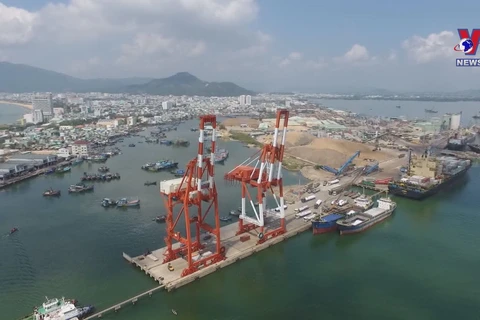 External risks and challenges still exist and continue to affect Vietnam's import-export activities. (Photo: Vietnamplus)
External risks and challenges still exist and continue to affect Vietnam's import-export activities. (Photo: Vietnamplus) Hanoi (VNA) – Given that production and business activities are facing various difficulties, consumption and disbursement of public investment have become a 'bright spot', and an important driving force supporting economic growth.
After the Covid-19 pandemic was kept under control, the Government issued many policies and solutions to remove difficulties and obstacles giving priority for economic growth. As a result, Vietnam's economy has gained positive results. However, external risks and challenges still exist and continue to affect import-export activities.
This is what Dr. Can Van Luc has emphasized when assessing the socio-economic situation in the first 5 months of 2023 in an interview with the VietnamPlus Electronic Newspaper.
Consumption becomes an important pedestal
- With the drastic management of the Government and the efforts of the whole political system and society, the economy has made positive changes. Could you tell me what are the bright spots in the general "picture"?
Dr. Can Van Luc: In the first 5 months of this year, the economy recorded some bright spots, including growth in the retail sector and improvement in disbursement of public investment. These are two important drivers of economic growth. Besides, two other bright spots can be mentioned, which are the stability of prices and the decrease of inflation and the bank interest rate reduction.
In May, the Government continued to promulgate many policies and solutions to remove difficulties and obstacles for the markets, promoting economic growth in the context of stable and controlled inflation.
In order to promote domestic consumption, the Government proposed 2%-reduction of value-added tax for the National Assembly’s approval, promulgating Decree 12/ND-CP on tax and land rent deferment and Resolution 82/NQ-CP on accelerating tourism recovery and development. Regarding monetary policy, the State Bank of Vietnam continued to reduce the operating interest rate and the ceiling on short-term deposits (the third reduction in a row within 3 months) and directed credit institutions to reduce lending rates.
Regarding foreign investment, the Prime Minister issued Directive No. 14/CT-TTg asking relevant quarters to further facilitate foreign investment attraction (improving the business environment, strengthening promotion and management). and production and business activities. Especially on May 26, the Prime Minister issued dispatch No. 470/CD-TTg on continuing to effectively carry out tasks and solutions to remove difficulties for firms and people’ production and business.
Thanks to theses efforts, the total retail sales of consumer goods and services in May reached 519 trillion VND, up 11.5% over the same period last year. In the first 5 months of the year, Vietnam welcomed more than 4.6 million international visitors, 12.6 times higher than the same period last year.
 Total retail sales of consumer goods and services in May reached 519 trillion VND, up 11.5% over the same period last year. (Photo:Vietnamplus)
Total retail sales of consumer goods and services in May reached 519 trillion VND, up 11.5% over the same period last year. (Photo:Vietnamplus) Given that important growth drivers, such as manufacturing and export sectors, are declining, the consumption sector has become an important pedestal supporting economic growth. However, the growth momentum of the retail and consumer sectors is also showing signs of slowing down.
Disbursement of public investment continues to be promoted and is an important driver for economic growth. In the first 5 months, the total disbursed capital reached 177 trillion VND, equaling 25.5% of the year plan and up 18.4% over the same period last year.
In addition, the interest rates continued to go down, the basic exchange rate was stable. Specifically, the deposit interest rate in May saw a slight decrease of 0.2%-0.5%/year, the operating interest rate was reduced by 0.5% to 5%, helping to reduce input interest rates and create favorable conditions for for credit institutions to lower lending rates.
 Dr. Can Van Luc assessed that consumption and public investment are still the two driving forces supporting economic growth. (Photo: Vietnamplus)
Dr. Can Van Luc assessed that consumption and public investment are still the two driving forces supporting economic growth. (Photo: Vietnamplus) Industrial production continues to face difficulties
- How do you assess the risks, challenges and causes of these problems?
Dr. Can Van Luc: Although domestic economic activities in May enjoyed positive changes, there are still many great risks and challenges. It can be seen that five main risks and challenges still exist, such as geopolitical risks and strategic competition among major countries that are still complicated and unpredictable. Especially, the Russia-Ukraine tension and sanctions and retaliation between the West and Russia are unpredictable, causing negative impacts on the global economy and also on Vietnam.
In fact, industrial production continued to face difficulties, with the index of industrial production in 5 months estimated to decrease by 2% over the same period last year.
The main reasons include the slow growth of the global economy, high inflation and interest rates, a decline in investment and consumption demand, and negative impacts on trade and foreign direct investment. As a result, the number of orders and the size of orders from key and traditional export markets shrank, weakening the export-manufacturing sector of Vietnam.
The number of enterprises temporarily suspending business in May increased by 20.3% and enterprises completing dissolution increased by 6.5% over the same period last year.
State budget revenue decreased for 3 consecutive months, reflecting the difficult situation of enterprises as import-export decreased.
Currently, businesses are facing four main difficulties and problems, which are legal problems, financial difficulties, high input costs, and imbalance between supply and demand in the labor market.
Four main groups of solutions
- In that context, what is the solution to promote production, creating a premise to revive the business sector in particular and the economy in general, in your opinion?
Dr. Can Van Luc: Relevant managing levels should focus on 4 main groups of solutions.
Firstly, it is necessary to promptly and accurately remove the shortcomings and problems that have been pointed out over the past time to substantially improve the investment and business environment.
Second, ministries, branches and localities need to organize a timely and effective implementation of the decisions that the National Assembly and the Government have issued, especially from the beginning of 2022 until now. Specifically, in the past 3 months, a series of decisions related to the fields of health, land, real estate, construction, finance, credit, import and export, among others, all need to be taken seriously.
 Businesses need to take into account the long-term problem, focusing on risk management, digital transformation and greening. (Photo: Vietnamplus)
Businesses need to take into account the long-term problem, focusing on risk management, digital transformation and greening. (Photo: Vietnamplus) Third, all levels should soon decide and issue additional mechanisms and policies.
Finally, businesses must seriously carry out restructure and reduce costs, and properly settle debt repayment commitments (accept to sell assets, if necessary). Moreover, businesses also need to consider longer-term problems, such as focusing on risk management, digital transformation and greening, because this is also the current inevitable trend.
Thank you very much!






















